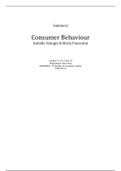Summary
Consumer Behaviour
Isabelle Szmigin & Maria Piacentini
Chapter 4, 6, 8, 9 and 10
Wageningen University
MCB20806 – Principles of consumer studies
2020/2021
, Chapter 4 – learning and memory
Demonstrate understanding of the main approaches to learning
Learning: activity/process of acquiring skill/knowledge by studying, practicing or
experiencing something.
- Leads to changes in attitudes, beliefs and behaviors.
Two types of learning:
1. Behavioral learning: learning as a response to changes in environment (external
stimulus)
2. Cognitive learning: learning through internal mental processes and conscious
thought.
Understand what is meant by behavioral learning, and the difference between
classical and operant conditioning
Behavioral learning: learning as a response to changes in environment (external stimulus)
Classical conditioning: Ivan Pavlov (the experiment with the dogs who expected food when
they hear the bell ring)
1. First-order conditioning: Conditioning Stimulus (CS) acquires motivational
importance by being paired with an Unconditioned Stimulus (US)
2. Higher-order conditioning: pairing of two CS
Extinction: If the US is removed from the CS, over time the response will also be removed
Stimulus generalization: when a stimulus similar to a CS elicits a similar response (used with
f.e. brand extensions or private labels)
Stimulus discrimination: when discriminating between two similar stimuli
Operant conditioning: (a.k.a. instrumental learning): B.F. Skinner: changing behavior
through reinforcement following a desired response (experiment with hungry pigeons, lever
and food)
- Acquire learning through behavior, which has a positive outcome, known as positive
reinforcement
- Neutral operants: some behaviors neither decrease nor increase the likelihood of
repetition (unimportant behavior, neutral response)
- Good services or free samples act as a positive reinforcement.
Reinforcement schedules: how and when to apply reinforcement
o Fixed ratio schedule: after specific number of responses
o Fixed interval schedule: after a specific know period of time
o Variable schedules: on an irregular basis
, o Variable interval: unknown but consistent rate
Learning history: used to adopt appropriate behavior
o Learning product or service environment needs to be easy
Describe the different modes of cognitive learning
Cognitive learning: learning through internal mental processes and conscious thought.
- Internal mental processes
- Based on the view that humans are broadly rational and use available information in
their environment to make decisions
- Can operate in high and low involvement situations
- Active or passive
information processing model: how communications are received, interpreted, stored in
memory and retrieved. Information received from environment passing through cognitive
process:
1. Exposure: sensory detection, registration trough receptor organs
o Successful exposure to stimuli depends on confirming consumer’s
experiences and belief
2. Attention: focusing of attention, leading to perception and categorization of stimuli
o Novel stimuli: not immediately interested in the information but attracted to
the communication, information might be rejected later.
3. Comprehension: searching and identifying meaning
4. Acceptance/rejection: considering existing choice criteria, elaborated received
message to reach point of acceptance or rejection the information.
5. Retention: learning retained for future use
Explain the different functions of sensory memory, short-term memory and long-term
memory
Memory: system and process whereby information is received, sorted, organized, stored
and retrieved over time. (This does not take place in a certain physiological place).
- Central to understanding how consumers make decisions
Encoding: how information enters the memory. Avoiding ambiguity is important
Storage: how encoded information is retained in memory
- Connecting with old information
- Memory protection: special memories protected
Memory system
- Sensory memory: Very short time (less than a second)
o received in sensory form
o Essentially automatic, no particular attention or interpretation needed





